Author // Emily Rozmus Friday, 21 March 2025
When I was teaching poetry in my secondary English classrooms, one of my favorite poems to share was [In Just] by e.e. cummings. With words like "mud-luscious" and "puddle-wonderful" and images of a "goat-footed balloonMan" crying "far and wee," there's so much to love about the story cummings tells. My students were usually confused at first, but as we unpacked the words and dissected the form, they began to see the picture of the spring day. The poem blooms with laughing children running breathless in packs, hearing and answering the pagan and ancient call of spring.
For me, the joy of poetry is finding the story or uncovering the picture created by the intentional use of figurative language, rhyme, and rhythm. It is about the play of words and phrases. The arrangement of lines and punctuation helps evoke emotion, whether playful and bright or dark and serious.
Ohio's Learning Standards for English Language Arts ask students to read, write, listen, and speak. Poetry can be a powerful vessel for supporting standards in each of these areas. One poem can generate close reading of complex text to determine the author's purpose or word choice. It can be read aloud with meaning and tone while others listen to evaluate and infer. Writing about poetry can take numerous forms, from analytical to persuasive, and even narrative.
INFOhio's premium resources provide PreK-12 educators with quality instructional materials for poetry to support Ohio's Learning Standards for English Language Arts. Review the suggested materials below and consider how you can use them this April to shower your students with poetry.
Students ages 3-5 develop essential literacy skills when they are exposed to multiple text types with a variety of purposes. Be intentional in choosing rhyming, lyrical text found in poetry, but also in chants, books, and nursery rhymes. For example, BookFlix, a collection of more than 140 quality eBooks, provides several titles that will develop expressive language, fluency, and phonological awareness.
To find eBooks with poetry or rhyming text in BookFlix, click the apple and book icon to access the Resources and Tools. You can search using helpful filters to narrow your results. For example, under All Themes, choose Music and Dancing or Poetry and Rhyme. You can also use the last filter to narrow the eBooks to PreK-1.
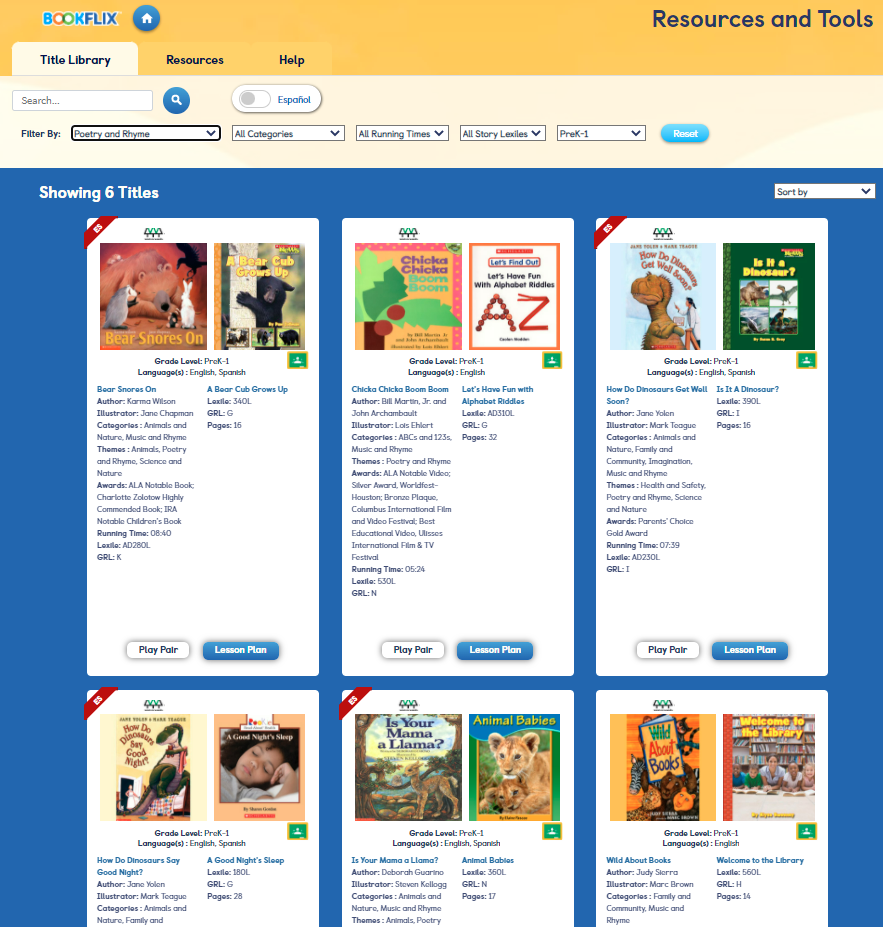
Once you apply the filters, review each pair to see which will meet the needs of your students. Each pair has a lesson plan and additional features to support their use in the classroom, including games and websites. Play the eBook for preschoolers. Talk more about new words in the texts, repeat rhyming chants, and ask students to find rhyming pairs.
Another resource has nursery rhymes and essential texts for early learners. Find nursery rhymes in the Early Learning Basics section of World Book Early Learning. Choose Once Upon a Time to access a number of nursery rhymes that feature a read-aloud option.
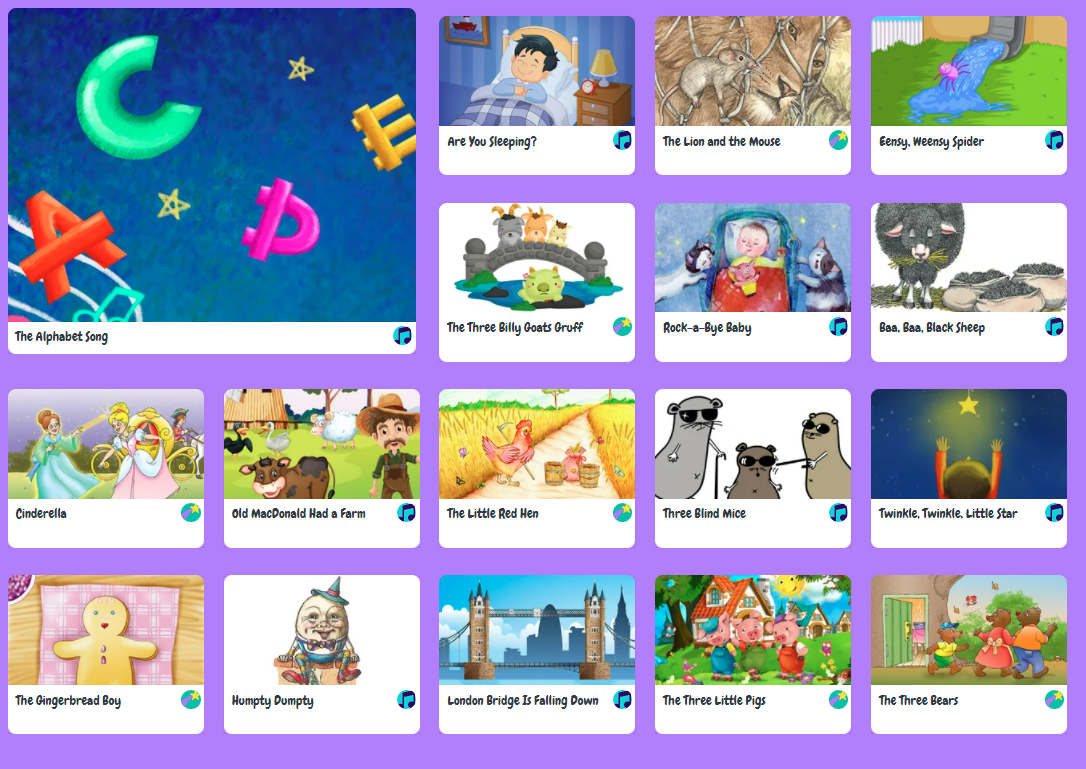
Once students have read and listened to rhyming, lyrical text, ask them to draw about what they heard. They can dictate what they know about the poem or song using resources from INFOhio Early Learning Portal. This collection of websites and apps were chosen by Ohio early learning professionals to support Ohio's Early Learning and Developmental Standards. Choose Educators, Language and Literacy Development, and Writing. The apps and websites here not only help students with handwriting and letter recognition, but they will also support early writing projects. If you have access to iPads, Draw and Tell is an easy app to use where students can draw and write about text.
As students are learning to read, the resources shared above for preschoolers are still beneficial. Be sure to check out BookFlix, World Book Early Learning, and INFOhio Early Learning Portal to support emergent readers.
By second or third grade, many students are ready to read, comprehend, and respond to literary and informational texts independently and proficiently. Complex text includes poetry and its various forms. Helping students recognize the features of poetry supports their understanding of it and how to approach it. Highlights Library is another INFOhio resource with quality text. Two titles in this eBook collection will help early readers understand the features of poetry. Search for What Rhymes with Cat? in the search bar. This is the perfect title to help students understand the fundamentals of rhyming and creating rhyming lines. Does poetry always rhyme? Of course not! Support students who want to create free verse by reading The Poetry Party with them. All types of poetry can support students in determining the meaning of words and phrases in a text. Learning about poems helps readers distinguish literal from nonliteral language and identify similes, metaphors, and other examples of figurative language.
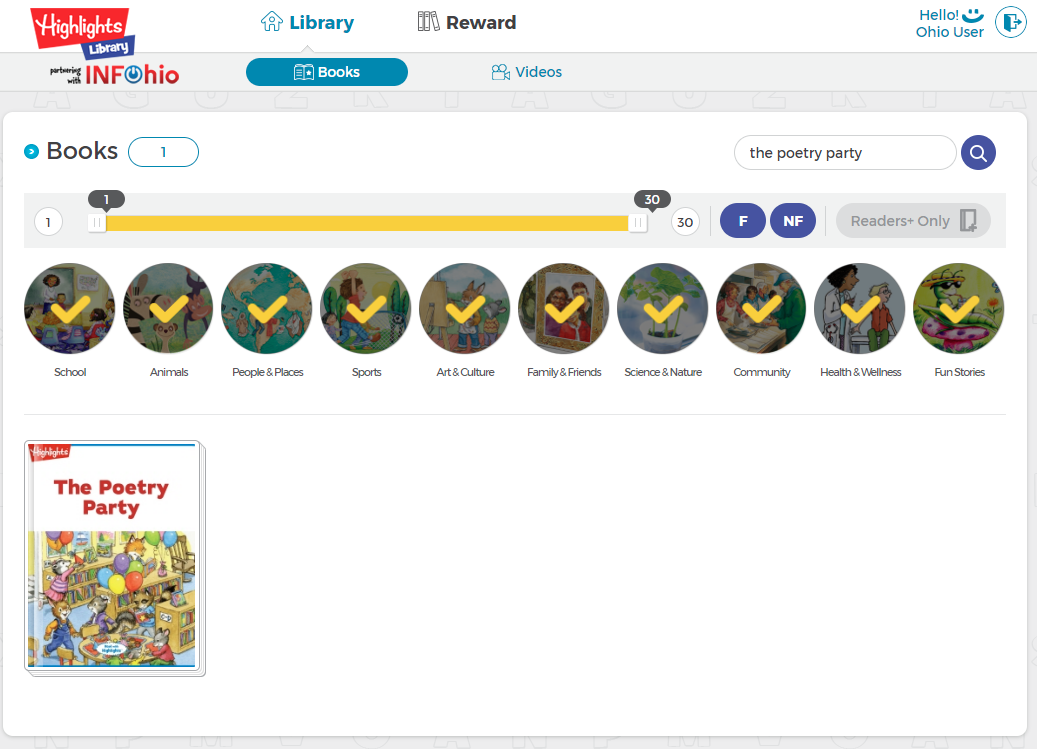
For easy poetry activities, use World Book Kids. Click Activities from the menu at the bottom of the resource and then choose Write It Down. Students can try writing their own poems after they read more about the different features and types of poetry.
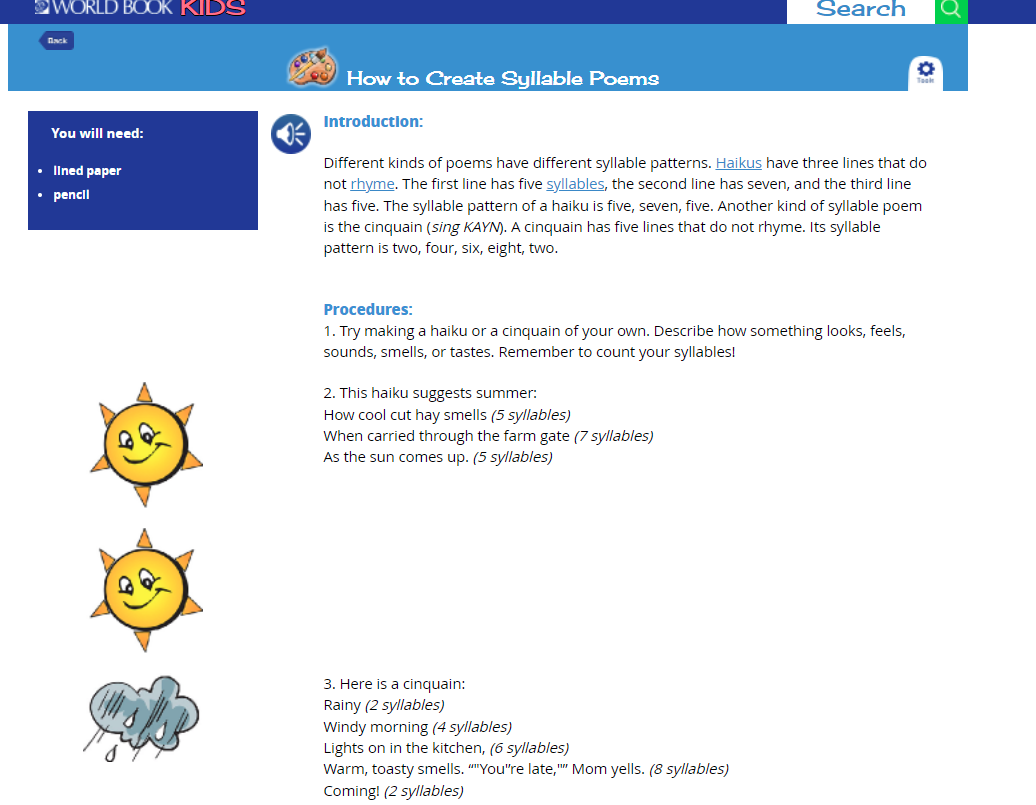
The World Almanac for Kids Elementary is also helpful when using poetry to support Ohio's Learning Standards for English Language Arts. Students can write poetry to develop descriptive details essential for narrative writing. Choose Topics in The World Almanac for Kids Elementary and scroll to The Writer's Corner. Choose Poetry and ask students to choose one of the poem types to practice using descriptive and figurative language. For example, students can write an acrostic poem using their first name and include descriptive, powerful words to describe themselves. Challenge them by encouraging students to use a thesaurus to find tier two and three vocabulary words.
Writing a biography after an author study is another great way to include poetry in lessons and meet Ohio's Learning Standards for English Language Arts. Students can research to find information about a poet and write an organized essay to inform others about the author. PebbleGo Next is an INFOhio resource that provides poet biographies. Click the Biographies database on the homepage, and then choose Artists and Writers. Narrow the search by choosing Writers. Help students identify poets such as Amanda Gorman, Langston Hughes, and Suzan Shown Harjo to research.
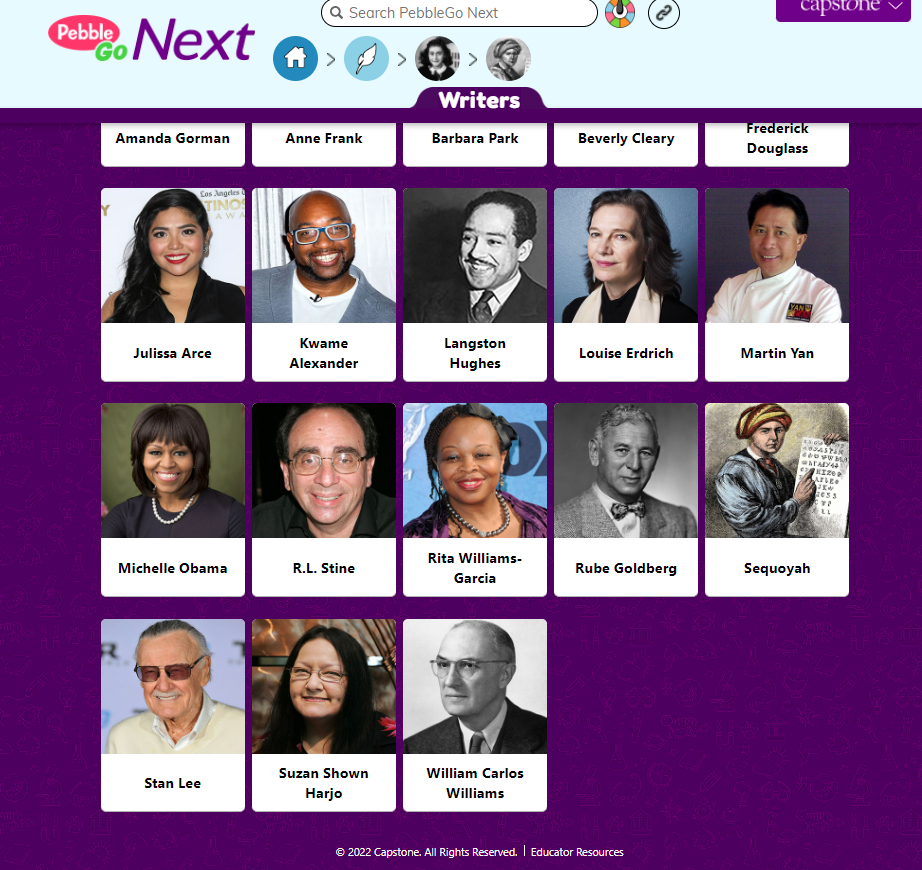
Another resource with poet biographies is Explora for Grades PreK-5. Students can search by the poet's name in the search bar, or they can browse by clicking Arts and Music and Poetry. Use the filters to the left to narrow results by Lexile Level or source type. Students can also search for the poet's name here to ensure their results are associated with the poetry of the individual.
Boost middle school students' vocabulary and background knowledge with poetry. Several INFOhio resources provide poetry resources to meet Ohio's Learning Standards for English Language Arts.
Explora for Grades 6-8 provides quality content to support lessons on poetry. Search for rhythm to find articles such as Express Yourself with Movement and Rhythm...Have a Go at Performance Poetry. This is a great way to introduce rhythm while encouraging student voice.
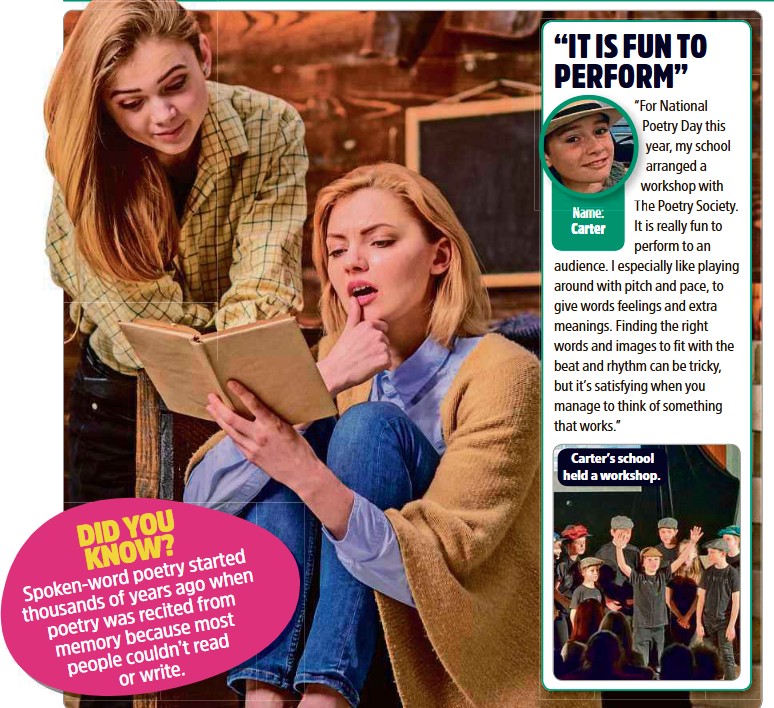
Browse the digital content in Explore Topics, Literature and Language Arts. Choose Literary Forms, Styles, and Techniques then Literary Forms and Genres. Choose Poetry for a curated collection of articles, eBooks, and videos on the topic.
In high school, students can explore the relationships between poetry, art, and history. Search for poetry in World Book Advanced to find Marianne Moore's poem called Poetry. This poem is a creative endeavor about the meaning and importance of poetry. It is also "an argument for both escapism and reality in art." Ask students to read it and research its creation, figurative language, and historical allusions. An analysis of the poem is included and students can defend it or develop their own. The "Poetry" article in World Book Advanced contains helpful information to help students craft their response to the poem, including types of poems and elements of poetry.
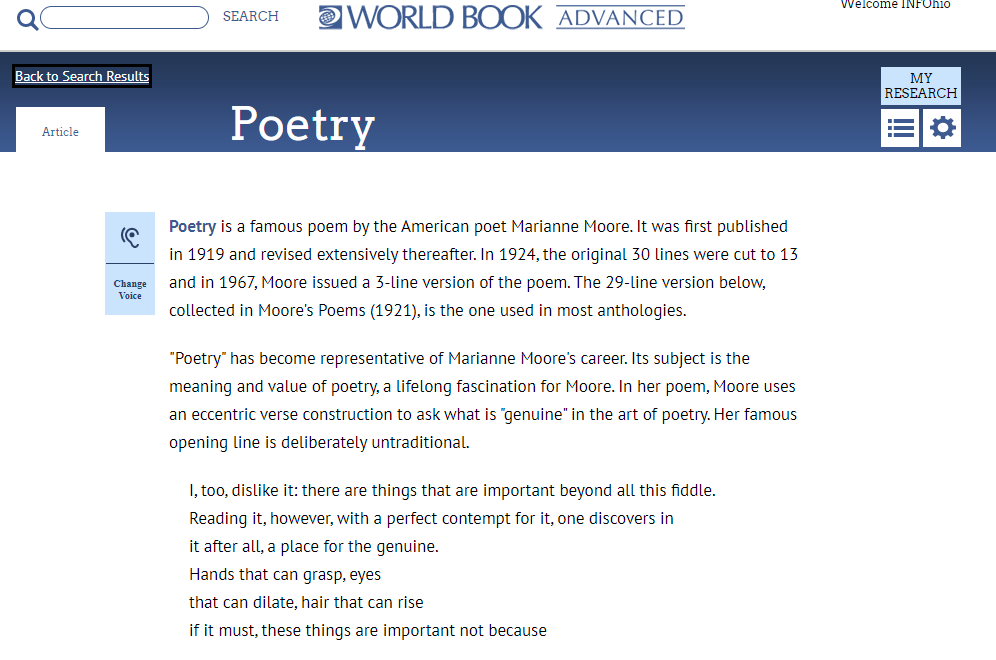
Students can take their study of poetry further by reading reviews and analyses of poems in Literary Reference Source. Ask students to choose a poem to analyze and find examples in the database. Ask them to determine the components of poem analyses to help them write their own. Students can also find the full text of many classic poems which can be saved or downloaded for annotation and further study.
If students wish to learn more about poetry or read more poems, share the Literary Criticism eBooks collection with them. This includes classic titles as well as Bloom's Guides. Search for authors, titles, or keywords to find poetry eBooks. These eBooks have a text to speech option.
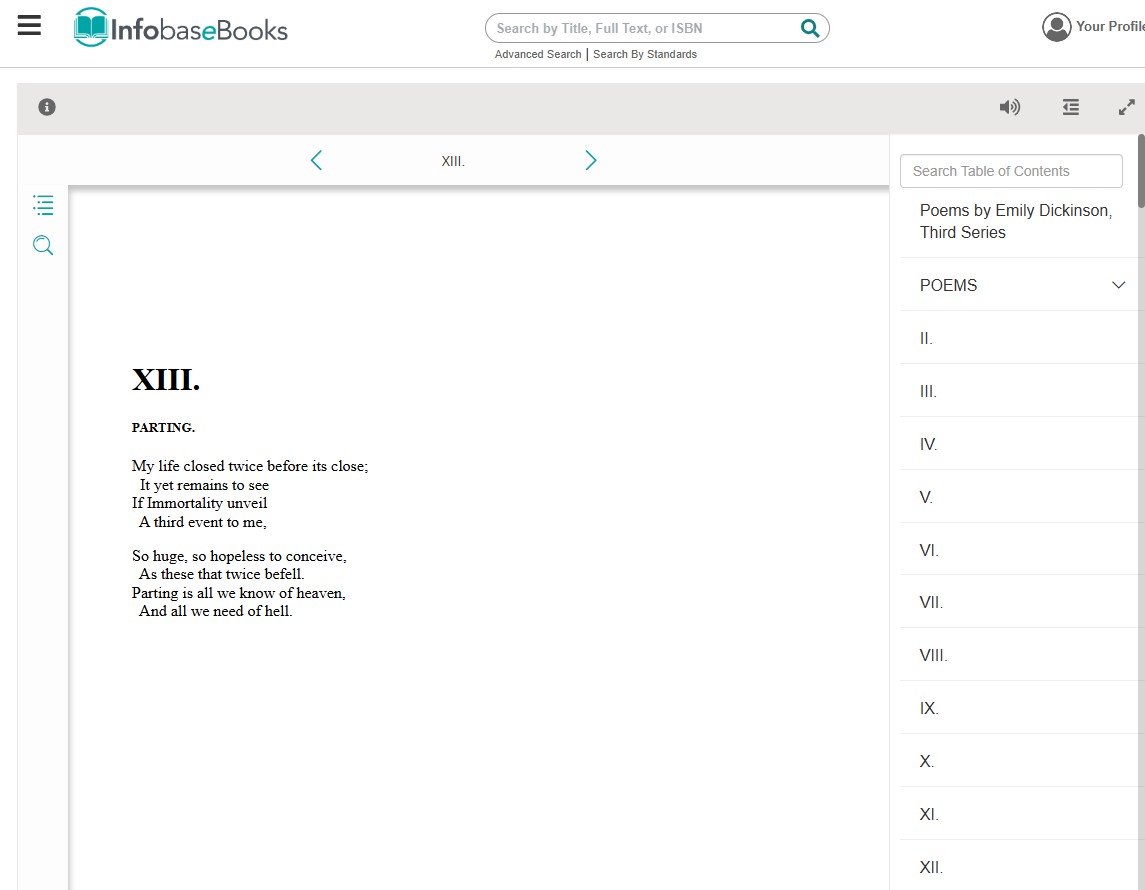
Shower your students in all grades with the rhythm and rhyme and word innovations of poetry. INFOhio has the quality instructional materials you need to make April a perfect storm of creativity! Share how #INFOhioWorks for you on social media.
INFOhio is here to support you. If you have questions or specific needs, reach out to us at support.infohio.org.
Emily Rozmus is a Senior Instructional Specialist at INFOhio. She has worked in education for more than 30 years, first as a secondary English teacher and district librarian before starting at INFOhio in 2013. Emily has developed district growth plans, integrated technology, created instruction for information literacy, fostered teacher development, and worked on teams to implement curriculum. At INFOhio, she focuses on training educators to use INFOhio resources to improve learning.
Fetch is avaiable to INFOhio automated schools. If you are an INFOhio school, please log in with your school username/password using the button at the top-left corner of this page.
For more information about Fetch, please visit the Fetch information page or contact INFOhio support at https://support.infohio.org.